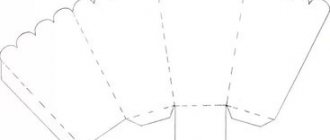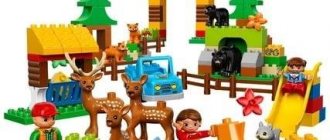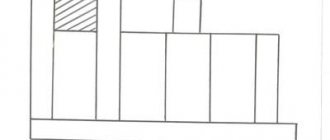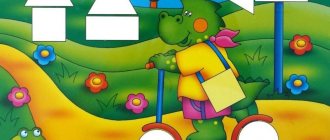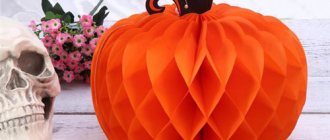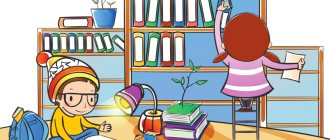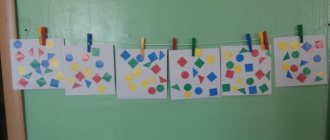Goals and objectives of design classes
The teacher should set himself the task of not only teaching children to perform certain actions, but also implementing their personal craft projects, making them from “waste material”, simply put, from garbage and rubbish. It is construction in the middle group that opens up a huge field of activity for imagination for young creators, teaches kids to achieve their goals, to cherish and appreciate their own and other people’s work.
Every lesson in kindergarten is like a trip to a fairy tale world. And construction in the middle group is no exception in this regard. Therefore, the lesson should begin with a short introduction, a kind of mini-performance in which children should take part, answering questions from the teacher and the characters in the miniature. In this way, children's speech skills and logical thinking are used. Construction in the middle group can involve skills acquired in music classes, when children are asked to sing some song they have learned previously.
Card index of construction games for the middle group
Yulia Mikhailovna Voronina
Card index of construction games for the middle group
September
1.“Building a house for a cat, a dog and a goat”
Goal: Develop children's ability to build a house. Learn to build in the required sequence. Promote cooperative play
2."Animal pen"
Goal: Learn to build from vertically placed bricks. Foster careful handling of construction. Activate vocabulary: brick, pen.
3."Tower, bridge"
Goal: Learn to build simple buildings; consolidate building techniques from the bottom up.
4."The High and Low Tower"
Purpose: To consolidate the names of building materials, the concepts of “high - low”
,
“more is less”
, the ability to build towers of different sizes and colors, maintaining proportions, using prisms to decorate
the structure .
October
1."House for a Bear"
Goal: To develop the ability to build toy houses, focusing on a model; cultivate respect for the construction profession.
2."Let's build a path for the car"
Goal: Develop skills: build a path, placing bricks next to each other with short edges, distinguish parts of buildings by size, build according to your own plans, interact in games.
3."Doll bed"
Purpose: Show children on a sample model that the building contains the necessary parts; continue to train children to build according to the model proposed by the teacher.
4. "Building a truck, roads"
Goal: To consolidate the ability to tightly lay bricks flat to each other with the narrow short side (road)
.
Place the cube firmly and evenly on the second brick (machine)
.
November
1."Gate for Aibolit car"
Goal: Learn to build a gate from two vertically standing bricks, on which another brick is placed
2."The doll has a housewarming party"
Goal: To consolidate the skills and abilities of working with building materials, teach them to play with buildings, and enrich the experience of children. Construction of furniture, rooms in various ways.
3."Table and chair"
Goal: To develop the ability to select materials for furniture in accordance with the desired size; improve design skills
4. "Town for Dolls"
Goal: Continue to create buildings according to the general plot. To develop the ability to design at will , to cultivate the desire and ability to build calmly together
December
1."Ladder for the turtle"
Goal: Continue to teach children to create buildings, put parts on top of each other and place them next to each other; recognize and name building materials and buildings.
2. “Narrow bench for Bunny - Long Ear, wide bench for Mishutka”
Goal: Learn to build a narrow bench from two bricks and a plate and a wide bench from four bricks and two plates.
3."Bridge for pedestrians"
Goal: Continue to learn two ladders and make an overlap (put a plate on top, play with the structure. Vocabulary: ladder, height, on top, bridge, next to, plate.
4."Different Cars"
Goal: To strengthen children's understanding of the color and name of building parts, construction . Teach children to compare buildings and notice their differences.
January
1.“Building a steamship, a boat. The doll's trip to visit"
Goal: To strengthen children’s ability to place bricks tightly together, placing them on the long narrow side, depicting a boat or steamship. Distinguish the details of the bow and stern.
2. "Let's build a doll shop"
.
Goal: To consolidate the ability to build a store from cubes and bricks, to bring the job to the end, to cultivate friendly relations in the game.
3. "Zoo for wild animals"
.
Goal: To consolidate skills in joint activities with the teacher (build cages for animals)
; continue to learn how to play around with your construction.
4. "Zoo"
.
Goal: To consolidate the ability to build houses for different animals from cubes; develop respect for animals.
February
1. "Let's build a house for animals"
.
Goal: Develop memory, speech; Encourage children to create design by adding other details.
2. "Garage"
.
Goal: To consolidate the ability to build from parts of a large builder; beat the building.
3."Let's build a house for a bunny"
.
Goal: To develop children’s constructive skills , the ability to demonstrate how to build simple structures , and enjoy the results; consolidate the names of details and verb forms in speech; develop motor skills, the ability to correlate movements with words.
4."Let's build a house for the bear"
.
Goal: To develop children’s constructive abilities , to teach them to correlate the size of a building with the size of an object; consolidate knowledge about construction details; develop the planning function of speech.
March
1. "Terem for Animals"
.
Goal: To develop children’s constructive skills , learn to compare buildings with the size of an object, learn to pronounce a sequence of actions in speech.
2. "At the request of the children"
.
Goal: Improve children's skills when working with construction sets , learn to decorate the design , play with it; bring pleasure from games and collective activities.
3."Garages for cars"
.
Goal: To consolidate knowledge of the names of building materials; cultivate the desire to build together, amicably.
4."House for Dwarves"
.
Goal: To consolidate the ability to design objects (houses)
in accordance with certain conditions.
April
1."Furniture for a doll"
.
Goal: To develop children’s constructive abilities , the ability to create simple buildings; consolidate knowledge about furniture and its purpose.
2.“Construction of houses for kittens of different sizes”
.
Goal: To consolidate knowledge of the concepts “big - small”
;
develop constructive skills , speech.
3. "Trucks"
.
Goal: Develop children's constructive abilities , fine motor skills of fingers, learn to build cars from LEGO construction sets
; learn to play without conflicts, in harmony.
4."Garages for transport"
.
Goal: To teach children to organize themselves into groups and unite with a common plot, to teach them to play without conflicts, in harmony. Offer small toys to play with.
May
1."Two-storey house"
.
Goal: Look at illustrations with multi-story and two-story houses, develop the ability to independently enclose a space when building a house, and build on the upper floor.
2. " Designing according to your own design"
Goal: to encourage children to rebuild this or that building (arrange, expand, lengthen)
creating a game situation.
3. "Dog Kennel"
Goal: Learn to make buildings according to a verbal description and a diagram
4. “House with a fence
Goal: To teach children to follow the construction plan, take into account color, shape, size
Working with scissors, paper and glue
The simplest material for children's creativity is paper. Children begin to create their first masterpieces from it almost from the age of one year. The middle group also enjoys creating from this accessible material. Paper construction is a separate section in planning manual labor classes.
Children happily create crafts as gifts for their families. You can invite them to make a fun frog toy by handing out the part templates first. The teacher should show the kids how the package-body of a cute frog is glued together, how the legs, eyes, and spots are attached. Before this, you can give one lesson to designing the picture “Frog eats a fly” in the middle group.
As you work, you can tell the children a short tale about the sad frog Frog, who considered himself useless to anyone on earth.
“Who knows what benefits frogs bring?” – the teacher should ask. And, by showing a finished sample of the craft, thereby leading the children to the answer: these amphibians destroy insects - mosquitoes and flies - that pester people and animals.
“Rocket” – GCD for paper construction
Smirnova Irina Grigorievna Tregubova Larisa Viktorovna Grebenikova Tatyana Alekseevna educators MBDOU "Kindergarten of the village of Tomarovka of the Yakovlevsky urban district"
The material was sent for publication in the All-Russian printed collection of practice-oriented materials “Preschool and primary education - modern methods and technologies of teaching and upbringing” - July-August 2022.
ROCKET NOD in the senior group - paper construction
Goal: to expand children's understanding of space. To develop the ability to create a three-dimensional design of paper rockets using a diagram and a sample.
Advertising message
Tasks:
- Educational: consolidate the names of geometric shapes: circle, rectangle, triangle; construction parts: cone, cylinder, cube. Teach children how to twist a rectangle into a cylinder, a circle into a cone.
- Developmental: develop design skills, the ability to convey the expressiveness of a composition, using the features of paper as a design material. Develop spatial thinking, imagination, and the ability to make inferences. Form a critical attitude towards your actions, objectively evaluate your work and the work of your comrades.
- Educational: to cultivate interest in paper construction. To cultivate accuracy in working with glue and scissors, independence, and initiative. Cultivate a desire to help a friend.
Integration of educational areas : Speech development, cognitive development, artistic and aesthetic development.
Enrichment and activation of the dictionary: Space, cosmodrome, planets, astronaut, orbit, body, nozzles, porthole, design bureau.
Methods and techniques: game problem situation, riddle, conversation - dialogue, looking at illustrations, outdoor play, verbal play, productive activity of children, self-analysis of work, summing up - reflection.
Equipment: a letter asking for help, illustrations depicting rockets, a sample of a finished rocket, parts of a three-dimensional construction set, an audio recording of space music.
Handouts: rocket design diagrams, cardboard, colored paper, scissors, glue, napkins, oilcloth.
Progress of continuous educational activities:
Cheerful music plays and children join the group.
Educator: Guys, today we have guests, let's say hello and invite them to come.
Children: hello!
Educator:
We will all stand in a circle together, You are my friend and I am your friend, Let’s hold hands tightly and smile at each other.
The teacher makes a riddle about space.
Educator: Guys, it’s not in vain that we started talking about space! Today our group received a letter asking for help. Shall we read it? (Yes!)
Educator: Dear guys! Soon there will be an epidemic on the planet “Zhelezyaka”! All the rockets and aircraft here have broken down, and the robots cannot make their flights. Help!
Guys, let's help the robots from the planet "Zhelezyaka"? How can we help robots?
Children's answers: Make rockets and launch them into space onto the planet.
Educator: Can you?
Children: Yes!
Educator: Who creates rockets? (designers, engineers)
Educator: today I suggest you be designers and design rockets for the inhabitants of the planet “Zhelezyaka”. I, as the chief designer, propose to consider rockets (there are illustrations of rockets on the easel)
Next, children examine a sample of a finished rocket made of colored paper and cardboard.
Educator: What parts is the rocket made of?
Children's answers: The nose of the rocket is made of a cone, the main part - the body - is made of a cylinder, the nozzles are made of triangles, the windows are made of circles.
Educator: but before you start creating rockets, do you want to play? (Yes!)
Outdoor game “Lay out the details of the construction set”
Children are divided into two teams and come up with a cosmic name for their team. Countdown: 3, 2, 1 – Start!
After the game, the teacher says that creating a rocket is a difficult and responsible job. You can pair up, agree on who will do what, and help each other.
Educator: please go to the design bureau!
Repetition of the rules for working with scissors and glue.
- Scissors must not be left open.
- You should not bring scissors close to your face.
- Pass the scissors to each other with the rings first, not the tip.
- Handle the glue carefully.
Look how many dangerous objects are lying around! If you do not follow safety precautions, you can injure yourself or a neighbor!
Educator: Guys, we have a problem! As you already said, to design a rocket you need a cone and a cylinder, we don’t have them.
But there is a design scheme. She will help us.
Look at it carefully and tell me, from what geometric figure can you get a large cylinder?
Children's answers: from a large rectangle, twisting it into a cylinder - a rocket body; from the circle, twisting it - the nose part. We attach the airlocks - triangles, and the portholes - circles to the body.
Educator: It's time to get to work (on the tables there is a set of geometric shapes for each child - a large rectangle, a circle, two triangles, small circles for portholes). During the activity, the teacher provides individual assistance.
Children place finished rockets in one line at the Mechta cosmodrome
Presentation of finished works
Educator: What beautiful rockets you have made, but can all rockets fly to the planet “Zhelezyaka”?
I'll give you one gold star. This is your voice. You will give it away - vote for your favorite work - (put a star next to the rocket).
Which rocket gets the most stars will be considered the best. (This is how children perform visual analysis of work)
Educator: Well done designers! Everyone did it! Will the inhabitants of the planet “Zhelezyaka” like your rockets? (Yes!). Applause!
Educator: Guys, I’m wondering
- -What are people called who fly into space on spaceships? (astronauts)
- -What was the name of the world's first astronaut? (Yuri Gagarin)
- -What was the name of the ship that lifted him into the sky? ("East")
Guys, do any of you want to become an astronaut?
To become an astronaut, what qualities do you need to have? (to be strong, courageous, resilient, responsible)
Educator: You are right, but astronauts must also follow the rules.
Word game "Space rules"
- If you want to become an astronaut, you must know a lot, a lot...!
- Any space route is open to those who love... work.
- Only friendly starships can take with them…on a flight.
- We will not take the boring, gloomy and angry into… orbits.
- Our main rule is to carry out any... order
- Fast rockets are waiting for us to fly to... planets.
- Whichever one we want, that’s the one… we’ll fly.
Let's train like astronauts and fly. I think that now the robots from the planet “Zhelezyaka” will invite us to visit.
Reflection: Guys, what did we do today? Who did they help? What games did you play? Was it difficult for you? What was the most difficult thing? What did you like most? Children's answers.
Literature:
- Kutsakova L.V. Construction and manual labor in kindergarten: Program and lesson notes M: TC Sfera, 2022. – 341 p.
You can see the table of authors and learn more about the collections HERE
Origami by hand
Another option for practicing with paper is folding various figures from sheets. In addition to the obligatory demonstration of all stages of manufacturing a product, it involves the construction of diagrams in the middle group, which the teacher teaches to “read”, that is, to understand. Each action in the step-by-step master class has its own serial number and follows one after another. After the demonstration, it is appropriate to offer the kids printouts of diagrams for completing crafts with a mixed up order of actions - let the children themselves indicate with arrows what needs to be done.
Pencil holders made from toilet paper rolls
It's good if middle group construction planning involves working with items that most people would normally throw in the trash. For example, toilet paper rolls leave cardboard tubes that can easily be turned into funny bunnies by covering them with colored paper and attaching noses, ears, eyes and paws to them. Besides the fact that these little things look very cute, they are convenient for storing pencils and pens.
Construction using the origami technique “Fox” for the middle group
Goal: Continue to introduce children to the origami technique. Introduction to basic forms.
Tasks:
Educational: increase interest in origami through play, learn to fold a square in different directions, create compositions with paper products, consolidate technical skills in working with paper.
Developmental: develop attention, memory, fine motor skills and eye.
Educational: to cultivate interest in paper design, to cultivate independence.
Demonstration material: illustrations of a fox, finished craft, finished basic form, orange paper.
Handouts: orange paper for origami, scissors, black pencil for eyes and nose.
Repetition of the rule for working with scissors:
1. Store scissors in a specific place
2. Place the scissors with the sharp ends closed away from you
3. Pass the scissors to each other, rings first
Preliminary work:
Looking at pictures, illustrations, reading stories, fairy tales, poems and guessing riddles on the topic
Organizing time:
The teacher offers to look at a picture of a fox and asks them to tell who is depicted in the picture and what they know about the fox.
Conversation with children.
Educator: The fox is a beautiful animal. Her body is covered with thick red fur. The fox has a luxurious fluffy tail. She has short legs and a sharp muzzle. The fox's eyes are beady and glow with a cunning fire.
Foxes live all over the globe. They live not only in forests, but also in the tundra and steppes.
- Who can tell me, guys, what do foxes eat? - That's right, foxes eat hares, mice, birds, fish, and also like to eat berries, fruits, and vegetables.
Foxes are very careful. In case of danger, they confuse their tracks and hide them in other places. Because of this, the fox is called the most cunning animal.
Foxes live as a small family in a hole they dig in the forest. They have keen eyesight and sense of smell.
Foxes are considered useful animals; they eat small rodents.
Many fairy tales and stories have been invented about the red-haired beauty. What is another name for a fox? (Children’s answers.) That’s right, the guys call the fox “red-haired cheat”, “fox-sister”, “Fox-Patrikeevna”.
- And now, guys, I suggest making everyone their own paper fox, don’t you agree?
First we need to stretch our fingers.
Finger gymnastics:
Let's go for a walk (hands clenched into fists, thumbs running across the table)
And the second ones catch up (index fingers “run” across the table)
Third fingers run (“middle fingers run”)
And the fourth ones walk (“ring fingers walk”)
The fifth finger jumped (touch the table rhythmically with both little fingers)
And at the end of the path he fell (slam his fists on the table).
Practical part:
Creating a fox using origami technique.
1.Fold the paper and cut out a square
2. Take the opposite corners and fold our square in half
3. Bend the end of the triangle to the opposite middle
sides.
4. We bend the left and right side ends upward to create ears.
(The teacher shows the sequence of techniques for folding a figure, draws attention to accuracy in working with paper. If necessary, provides individual assistance.)
- So we have the face of a fox. What is our little fox missing? (Children's answers.) - That's right, of course the nose and eyes are missing. To do this, we will draw them with a black pencil.
But before that, let's have a physical moment with you. (Children get up for physical exercise.)
Physical education minute:
Three nods.
Four - arms wider,
Five - wave your arms.
Six - sit down quietly.
- Guys, now let’s draw our fox’s nose, eyes, and now our little fox is ready.
Lesson summary:
- Guys, what did we do today?
What did you get out of our lesson?
What other animals would you like to learn how to make from paper?
These are our little foxes!
Shorty houses
After getting acquainted with the work of Nikolai Nosov about little people from the Flower City, you can plan to construct a “House”. In the middle group, this activity can begin with the appearance of the Dunno glove doll. It is appropriate to record the character’s words on a voice recorder in advance so that the teacher does not have to open his mouth during the child’s remarks.
“Guys, hello! – the short one must say sadly. – Do you recognize me? Yes, I am Dunno from Flower City. You probably remember that all the shorties do not live in separate houses, but several people in one room. It's not very comfortable. After all, Gusla needs to study music, and Tsvetik wants to write his poetry at this time. Znayka likes to read her smart books in the evenings, and Avoska really wants to go to bed early - the light of the lamp disturbs him. The shorties all quarreled over this!” And Dunno wipes his nose with a handkerchief, as if he were crying.
The teacher here should ask the children if they can help the short ones. And if the guys don’t give the correct answer, then it’s appropriate for the adult to suggest: “Let’s make separate houses for them!” Here, I just have empty juice boxes, maybe they will be useful to us?”
Summary of a design lesson in the middle group “Furniture for nesting dolls”
Lesson notes for the middle group “Furniture for Matryoshkas”
Program content:
Educational tasks:
• Foster children’s neatness and caring attitude towards buildings.
Developmental tasks:
• Develop children's constructive abilities;
Develop the ability to distinguish between the number of objects (many - one).
Educational objectives:
Develop the ability to answer questions, repeat simple phrases;
To form the ability to perceive and reproduce movements shown by adults;
Form the habit of putting toys away when the game is over.
Preliminary work:
Looking at pictures of furniture; Conversation with children: “Purpose of pieces of furniture.” Material: Sets of building materials, nesting dolls, toys for playing with. Progress of the lesson:
Slide 1.
Process of involvement in activities:
Let's stand side by side, in a circle, Let's say “Hello! " each other. We are too lazy to say hello: “Hello to everyone!” " and "Good afternoon! "; If everyone smiles, a good morning will begin. - GOOD MORNING!
The teacher reads a poem by A. Bogdarin
Listen guys
Someone's legs are rushing towards us,
Along the path, along the path
Feet stomp and knock.
Hiding from you and me One doll inside another. There are polka dots on the scarves. What kind of dolls? (Matryoshka dolls)
Slide 2:
The teacher shows the children a matryoshka doll, she greets the children, and the children also say hello.
The teacher asks the children questions: Who came to visit us? How many nesting dolls came to us? (one - children's answers).
The teacher opens the nesting doll and takes out more nesting dolls.
Slide 3:
Asks the children: How many nesting dolls are there now? (many answers from children).
The teacher repeats to the children: there was one, but now there are many.
Slide 4:
Educator. The nesting dolls live in a large beautiful house. Their house has a lot of comfortable furniture. Let's see what kind of furniture it has?
Slide5-11
: (description of furniture)
5. This is...a sofa
6. This is... a chair
7. This is...a bed
8. This is...a chest of drawers
9. This is...a closet
10. This is...a table (ask what material the table is made of, form adjectives - wood, glass, metal)
What does the table have? These are...legs
And this is the table top.
11. This is... a chair, a stool (what is the difference between a chair and a stool?)
Guys, you should drink tea at the table. I suggest making a table and chair with your hands!
Do it with me.
Finger gymnastics “Chair, table” (lyrics by S. Marshak, movement by O, Litvinova)
This is a chair—they sit on it.
This is the table - they eat at it.
Slide 12.
Guys, a table, a wardrobe, a chest of drawers, a chair is... furniture
Educator. Guys, are the nesting dolls telling me something? (listens) There are a lot of nesting dolls, but there is little furniture in their house. How can we help the nesting dolls?
Children: we can build them furniture from building material.
Bird feeders
The kids really like helping someone in life, doing good deeds. Why not channel their irrepressible energy in the right direction and offer to do truly useful things? With great pleasure, kids will start making bird feeders from the same cardboard milk or juice boxes.
Of course, you need to play up the beginning of the design lesson. For example, it will be interesting to see a bird (a dressed-up artist or a toy) with a huge letter in its beak in class. After reading the message, children will learn that with the onset of cold weather, it has become extremely difficult for birds to find food under the snow.
The teacher should at this point invite the children to remember the lesson material on the world around them. The following guiding questions are appropriate:
- Which birds fly to warm countries with the onset of cold weather?
- Which birds stay with us for the winter?
- When do bullfinches fly away and why?
- Why do you need to feed birds in winter?
- What should be offered to birds as food?
Lessons on designing paper “Bunny” (middle group)
Summary of educational activities on designing from paper in the middle group on the topic “Bunny”
lesson plan on design, manual labor (secondary group No. 9)
Educator: Voitova Larisa Anatolyevna.
Topic: Paper construction “Bunny”
Target:
paper toy making training
Description
Objectives:
Educational:
- teach skills of working with scissors; — improve the skill of contour cutting; - develop an active vocabulary
Corrective:
- develop analytical-synthetic activity (composing figures from individual parts);
- develop the ability to navigate on a sheet of paper; - correct speech disorders. Educational:
- develop aesthetic taste;
- cultivate love and kindness towards animals; - cultivate accuracy in work. Equipment and materials:
Bunny (toy), white paper, scissors, glue, pencil, template, napkins, bunny sample, blank for decoration - carrot.
Progress of the lesson
Guys, we have guests today, let’s say hello to them. Children say hello. At the request of the teacher, they stand in a circle.
Stand up children, stand in a circle. I am your friend and you are my friend. Turn left, right and smile at each other. They stretched out their hands to the sun, caught the rays and quickly pressed them to their chests. With this ray in your chest you look at the world more clearly
Educator: Guys, I think someone is crying, let's look in the locker room. He takes the toy hare and shows it to the children.
The teacher speaks on behalf of the hare: “Hello, dear guys. My name is Vasya the hare, I want to tell you about myself. I live in the forest. I'm an excellent runner, I run very fast. When I feel danger, I immediately run away. During the day it is dangerous for hares to run through the forest - I am sitting in a hole. And in the evening I come out of my hiding place to eat and run around to my heart’s content. I am a herbivore. In summer I eat grass, various berries, in winter - tree bark, thin branches of aspen and birch. In winter, I change my gray coat to white so that predators do not notice me.
Educator: - Guys, what do you remember from Vasya’s story? Maybe you can tell us something else interesting about hares. Suggestive questions. (Children's answers).
.Bunny: Thank you guys, it was very interesting to listen to you.
-But I feel very lonely and sad alone in the forest. “All bunnies have friends, but I don’t. Educator: Guys, let's make Vasya some more friends so that he won't be scared and have fun in the forest? What do you think we will make from?
(From paper). Right.
Now let's make Vasya laugh and play with him.
.
.Physical training session Bunnies
Girls and boys, Imagine that you are bunnies. (Half squats with turns to the right and left) One, two, three, four, five, The bunny began to jump. (Jumping back and forth) Paws up and paws down, Pull yourself up on your toes. Bow to the left, to the right, Bend over and rise (Perform movements according to the content of the text) It’s cold for the bunny to sit, You need to warm your paws. (Squatting, rubbing your hands) It’s cold for the bunny to stand, The bunny needs to jump. (Performing jumps while standing still) Girls and boys , Imagine that you are bunnies. (Half squats with turns to the right and left) Someone scared the bunny, The bunny jumped and galloped away. (Turn your back, squat down, wrap your arms around yourself, lower your head down)
The children get to work. (go to the tables)
The teacher consistently shows how to make a toy. . Cut along the contour: -ears - 2 parts -torso - 1 part
-head-1 piece We fix the number of ears and paws for the hare. 5. Glue the parts to the head, ears, and the head to the body. 6. Draw the bunny’s face with a simple pencil and its paws according to the example on the board. 7. The teacher rewards each bunny with a carrot with the child’s name. Teacher: “Well, bunny, now you have a lot of friends.” The bunny thanks the guys for their friends and stays with them at the exhibition of children's works. Educator: “Well done, guys! You are kind children, you helped the bunny.
Design by Design
It’s good if children like to fantasize and offer their own ideas. Then you can offer to come up with your own crafts. This could be complex work on the project of a new modern children's playground for short children. Let this construction be called “Kindergarten”.
The middle group will be happy to take part in making tiny furniture for their pets. To create it, you can use boxes of different sizes or even plastic or cardboard disposable cups.
Construction from vegetables and scrap materials
This type of creativity opens the way for imagination. How many interesting things can be made even from ordinary potatoes! Stick matches into raw potatoes, make eyes out of grapes, and a nose out of currants - and there you have it, a funny hedgehog. And if you fasten a circle of cheese or a slice of the same potato in front with a couple of matches, make ears and eyes - you have a pig, clumsy and dirty. It’s even better to replace the matches with broken spaghetti noodles - you shouldn’t let the kids touch the matches, which they can take without asking until the adults are around.
During handicraft classes with vegetables, children enjoy making characters from Gianni Rodari’s fairy tale “Cipollino” and embodying the plots of other fairy tales. The voluminous compositions based on the fairy tale “Cinderella” are worthy of admiration, where the carriage is actually made of pumpkins, and the rat horses are made of potatoes.
Master class on making a handbag from cardboard plates
A design activity will help you make a craft that you won’t be ashamed to give as a gift. In the middle group, kids can be asked to make a wonderful handbag from disposable cardboard plates in the shape of a rabbit's face. To make it you will need three plates, two pieces of cotton wool, a button for the nose, a strap or a beautiful rope, scissors and a felt-tip pen. You can fasten the parts with glue or a stapler.
First, you should cut out the second half of the bag and decorative rabbit ears using the template.
Then the ears are attached to the whole plate.
Now the bag is completely assembled. Here you need to take care of the strap - it also needs to be securely fastened.
Cheeks made of cotton wool are glued to the front part of the craft, and a button-nose is attached between them. The eyes can be made from paper, or you can simply draw them with a felt-tip pen in the same way as the teeth. Here is a charming gift for your beloved mom!
Summary of a lesson on paper design in the middle group. Theme "Dog Kennel"
"Dog Kennel"
Goal: to learn how to make simple paper crafts based on a new design method - folding paper in half.
Tasks:
-learn to analyze paper crafts: identify parts, their spatial arrangement relative to each other, location of parts on a plane;
-learn to fold a sheet of paper in half (lengthwise, crosswise);
- learn to round two corners of a square so that it becomes a semi-oval;
-continue to teach how to work carefully with glue and napkin;
Materials and equipment (for each child): thick sheet of paper 11x22 cm; strip of brown paper 13x4cm; a square sheet of black paper measuring 5x5 cm; PVA glue; scissors; dog figurines; a booth constructed by a teacher from a box.
Progress of the lesson:
A ball game is played “Who lives in which house”. Children stand in a circle facing the teacher. The teacher has a ball in his hands.
Educator: Guys, I will throw the ball and name the animal or bird. And the one who caught the ball names where this animal or bird lives.
Throws the ball: Fox (in a hole), crow (in a nest), squirrel (in a hollow), etc. The game is played several times.
Children sit at tables on which everything necessary for work is prepared.
Educator: Look what I have prepared for you (shows his craft booth). Who lives in the booth? (dog). Yes, the dog Zhuchka lives in the booth with his puppies.
Next, the teacher analyzes the craft: My booth has a roof, it is glued to the wall on top, and a black hole is glued to the wall in the middle.
Educator: Zhuchka’s puppies will soon grow up, and it will be cramped for them all to live together. Let's help the dogs and build booths for them.
The teacher shows and explains the techniques: how to fold a thick sheet of paper crosswise and bend a strip of paper lengthwise; how to round off two corners of a square to make a hole for the dog, how to apply glue to a part, how to use a napkin, check whether it is well smeared. Invites children to examine the prepared parts.
Educator: Before we get to work, let's warm up.
Physical school is being held.
One - rise, stretch, (Stretched.) Two - bend, straighten, (Bent your backs, hands on the belt.) Three - clap your hands, three claps, (Clap your hands.) Three nods with your head. (Move your head.) At four - arms wider, (Arms to the sides.) Five - wave your arms, (Swing your arms.) Six - sit down again. (Sit down.)
Educator: Well done, now let’s get to work.
At the end of the lesson, all works are placed side by side. A large dog runs between them.
Educator: Guys, look how happy Zhuchka is. Apparently she really likes the houses you designed for her puppies. She thanks you. Let's let all the puppies out of the bug box, let them look at their future homes. Dasha, raise the booth, who did you find there? The girl takes out the dogs, the teacher distributes them to the children. Children play with dogs.
List of used literature:
Kutsakova L.V. Construction and artistic work in kindergarten: Program and lesson notes. –M.: Sphere shopping center. 2
Pasta turns into jewelry
And how luxurious products made from regular pasta look! Of course, for beads and pendants, it is best to paint shells in advance and dry them thoroughly. But a decorated craft in the shape of an angel can be coated with gold or silver paint directly from a spray can.
But most of all, children enjoy constructing designs from pasta by gluing them together. This is very reminiscent of working with a Lego constructor, however, in a ready-made set of parts, you can only connect them in the way that was previously conceived and provided for by the engineer. When working with pasta, no one puts barriers to the child’s imagination.
And from under children's hands come wonderful fairy-tale houses and amazing vehicles, cheerful and kind aliens and charming meadows with strange flowers.
